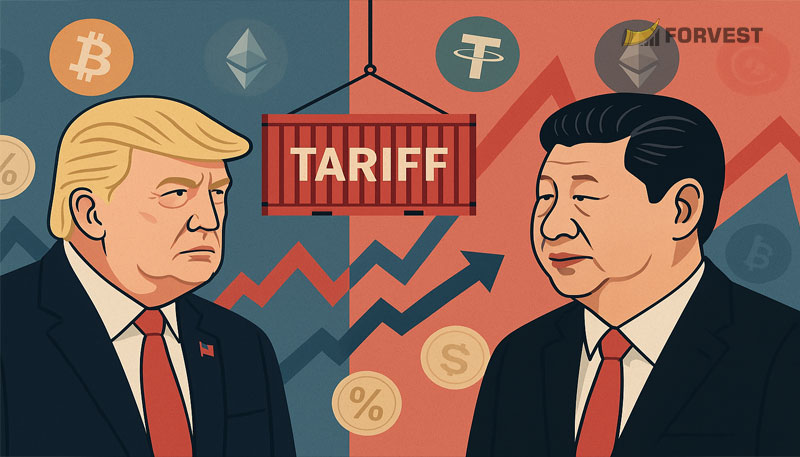How the U.S.–China Trade War Impacts Crypto Markets
How the U.S.–China Trade War and Tariff Changes Trigger Crypto Market Selloffs

TL;DR (Key Takeaways)
-
Escalating U.S.–China tariffs tend to spark “risk-off” selling across equities and crypto, while boosting safe havens like USD and gold.
-
Bitcoin and major altcoins sold off sharply after fresh U.S. tariff threats in October 2025, underscoring crypto’s high beta to macro shocks.
-
Over time, de-globalization and capital controls can support the “digital gold” and stablecoin cross-border use cases, but path-dependence is volatile.
Introduction
The U.S.–China trade war increasingly acts as a macro shock that ripples from traditional markets into crypto. Tariffs, export controls, and retaliation raise uncertainty, drain liquidity from risk assets, and amplify volatility in Bitcoin and Ethereum.
Understanding the U.S.–China Trade War
The conflict began in 2018 with layered U.S. tariffs on hundreds of billions of Chinese goods and rapid Chinese retaliation. A Phase One pause in early 2020 never fully normalized trade.
In 2024 the U.S. finalized steep sectoral tariffs—e.g., 100% on Chinese EVs, 50% on semiconductors, and 25% on battery parts—targeting strategic tech supply chains.
In October 2025, new U.S. plans to add a 100% blanket tariff on Chinese imports and fresh Chinese countermeasures (e.g., port fees; tech/export restrictions) escalated risks anew. Markets slumped and crypto fell in tandem.
Key industries affected: semiconductors, EVs and batteries, solar, and critical minerals—sectors tightly linked to global tech growth and risk sentiment.
Why Trade Wars Affect Crypto Markets
Liquidity flight. When tariffs or export controls rise, equities drop and funding conditions tighten; investors move into cash, Treasuries, and gold. Crypto, as a high-beta risk asset, often sells off faster.
Global risk perception. IMF research shows crypto’s correlation with equities has increased, particularly during stress, reducing diversification benefits. Spillover studies find crypto can transmit volatility across markets.
Regulatory uncertainty. Trade conflicts embolden government control narratives. China’s 2021 blanket ban on crypto trading/mining and ongoing enforcement constrain domestic participation and sentiment.
Capital controls and exchange rules. Tight controls in China, plus evolving U.S. rules for exchanges and stablecoins, periodically disrupt cross-border flows and risk appetite in Asia.
Case Studies & Historical Parallels
2019: As tariffs and yuan volatility spiked, crypto saw sharp, speculative moves; BTC rallied into June 2019, then retraced as macro uncertainty persisted.
2022 sanctions & stablecoins: Chainalysis shows sanctions designations reshaped crypto flows; stablecoins featured heavily in cross-border activity and enforcement actions.
2025 tariff headlines: October 2025 tariff shock coincided with a swift crypto drawdown, highlighting sensitivity to U.S.–China headlines.
Table 1 — Tariff Escalation Timeline vs. BTC/ETH Price Responses (selected events)
| Date & Event | Policy Shock | Immediate Market Context | BTC/ETH Direction* |
|---|---|---|---|
| Jul–Aug 2018: Initial U.S./China tariffs volley | Broad tariffs on $34–$50B tranches | Risk assets wobble | Mixed, higher vol. |
| Aug 5, 2019: CNY < 7 per USD | Currency stress tied to trade war | Safe-haven bid rises | BTC +7% intraday, then choppy. |
| Sep 13, 2024: USTR finalizes sectoral hikes | EVs 100%, semis 50%, batteries 25% | Tech supply chain jitters | Risk-off stints. |
| Apr 2025: “Tariff turmoil” headlines | Renewed tariff threats | Equities, USD whipsaw | Crypto correlation rises. |
| Oct 10, 2025: U.S. 100% tariff plan | Broad hike announcement | Stocks drop; gold jumps | BTC −8–10% same day; ETH lower. |
*Directional snapshots from contemporaneous reporting; medium-term paths varied.
Why Crypto Might Drop During Trade Wars
Liquidity crunch & deleveraging. Macro shocks tighten financial conditions; institutions reduce risk, hitting high-beta crypto first. BIS and IMF warn about crypto’s pro-cyclical volatility and transmission channels.
USD strength and funding stress. Periods of rising dollar or safe-haven demand often coincide with crypto outflows; market commentary frequently notes crypto’s inverse sensitivity to DXY.
Retail sentiment in Asia. Chinese restrictions and periodic OTC clampdowns weigh on participation and liquidity during stress.
Volatility spikes. Headlines about tariffs, export controls, and tech probes (e.g., Qualcomm) can trigger rapid repricing.
Near-Term Risks (concise):
-
Sudden tariff/probe headlines → sharp selloffs and slippage.
-
USD or rates spikes → de-risking across crypto.
-
Policy bans/sanction actions → stablecoin frictions, liquidity gaps.
Why Crypto Could Eventually Benefit
Digital-gold narrative. Over multi-year horizons, de-globalization and fiat risk can support Bitcoin’s “store of value” claim, especially alongside elevated gold.
De-dollarization vectors. Sanctions pressure has pushed experimentation with non-USD rails and sovereign stablecoins; cross-border pilots continue despite central-bank caution.
Stablecoin rails in trade. Even amid enforcement, private actors test stablecoin settlement for speed and capital-control workarounds, though risks are material.
Forvest Trust Insight
How to use Trust Scores in macro stress. Our Trust Score framework emphasizes liquidity depth, regulatory posture, counterparty risk, and on-chain resilience. In trade-war weeks, overweight higher-liquidity majors (BTC, ETH) relative to long-tail assets to reduce drawdown severity.
What this means for investors: If you systematically tilt toward higher-Trust-Score assets during tariff escalations, your downside typically decreases versus a cap-weighted altcoin mix. (Illustrative guidance; not a guarantee.)
Table 2 — Illustrative Forvest Trust Score Snapshot During Tension Weeks (Hypothetical)
| Asset | Liquidity Depth | Regulatory/Counterparty Exposure | Composite Trust Score* |
|---|---|---|---|
| BTC | Very High | Low–Moderate | 86/100 |
| ETH | High | Moderate | 78/100 |
| BNB | Moderate | Higher (jurisdictional) | 63/100 |
*Methodology: liquidity, market structure, exchange/issuer risk, and on-chain health. See Trust Score Analysis.
Expert Opinions & Data References
IMF economists find crypto–equity comovement rising, curbing diversification exactly when investors most need it. BIS work highlights transmission channels from crypto to broader finance in EMEs under stress.
Market reporters documented the October 2025 tariff shock driving simultaneous drops in U.S. stocks and crypto, a classic “risk-off” pattern. Sectoral tariffs in 2024 show policy’s focus on tech chokepoints, reinforcing sensitivity of crypto-adjacent narratives tied to semis and mining supply chains.
Chainalysis tracking shows sanctions enforcement reshaping flows, with stablecoins central in both legitimate settlement and illicit evasion attempts—raising tail risks during geopolitical escalations.
How Investors Can Respond
Diversify and defend. Use Portfolio Management to pre-define DCA bands and defensive sleeves (e.g., short-duration T-bill funds off-chain; higher-Trust-Score majors on-chain).
Follow Trust Score updates. In escalation weeks, tilt toward BTC/ETH liquidity, reduce long-tail exposure, and monitor exchange/issuer risk developments in stablecoins. See Trust Score Analysis.
Risk practices. Tighten position sizing, raise cash buffers, and set conditional stops only where slippage risk is tolerable. Rebalance on volatility spikes rather than headline noise.
Potential Offense (concise):
-
Accumulate majors via DCA during forced deleveraging phases.
-
Selectively rotate into staked ETH or liquid-staking blue chips with robust liquidity.
-
Keep dry powder for event-driven dislocations.
Conclusion — What the Trade War Means for Crypto in 2025
Tariff and tech-control salvos transmit quickly to crypto via liquidity, USD dynamics, and sentiment. Short-term, expect high beta and correlation to equities; long-term, Bitcoin’s reserve-asset narrative and stablecoin rails may strengthen. Track Forvest Trust Scores to keep your portfolio resilient through policy shocks.
FAQ
By raising macro uncertainty and tightening liquidity, tariffs trigger risk-off behavior that often pushes crypto lower alongside equities.
Yes—policy shocks increase volatility and cross-asset spillovers, with IMF noting stronger crypto–equity comovement during stress.
They can reduce price risk but carry issuer, sanction, and regulatory risks; enforcement actions have repeatedly frozen or rerouted flows. Chainalysis
Pre-set DCA ranges, size conservatively, favor higher-liquidity majors, and monitor Trust Score and counterparty updates. See Portfolio Management.
